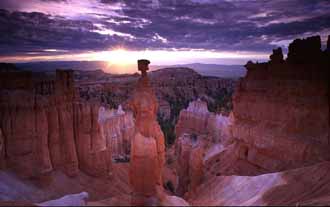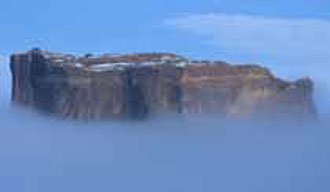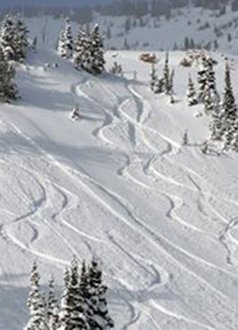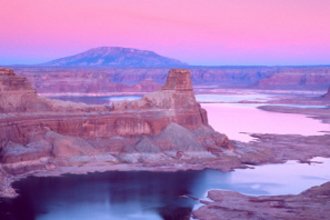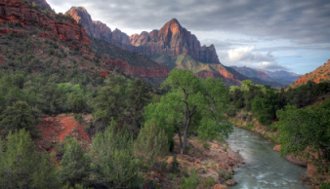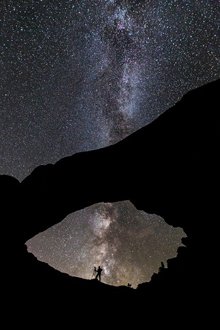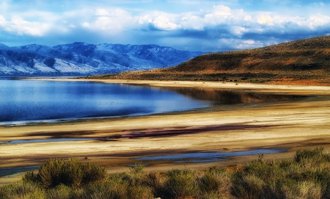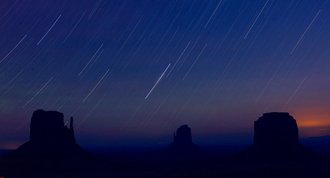That You Were Never The Same?
Great Salt Lake
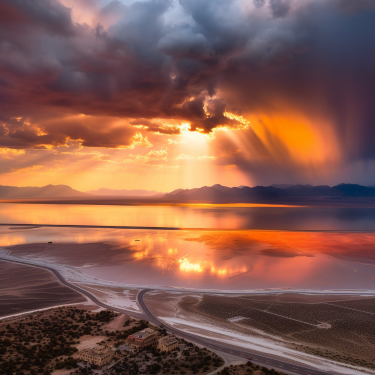
In 1824, Jim Bridger stood on the shore of the Great Salt Lake. But he thought it was the Pacific Ocean. It was definitely salt water. But why was it so close to the Rocky Mountains?
It also didn't make sense that it was just down the canyon from the lush Cache Valley? The first white man to see it didn’t realize what he was looking at.
Most visitors to Utah have heard about the Great Salt Lake long before they ever get here.
When it is full, it is the largest salt lake in the Western Hemisphere. The fourth-largest terminal lake in the world. The 37th largest lake on the planet.
Because there is no outlet other than evaporation, its salinity far exceeds seawater. It can be anywhere from two to eight times saltier than seawater.
That depends on the year and the runoff from the mountains actually reaching it. In any normal year, though, you can easily float in the lake due to its high salinity.
Of course, most of us thought it was going to dry up and disappear due to the drought Utah suffered over the last few years in Utah. The doomsayers had the "dangerous", chemical-laden dust from the dried up lake sweeping over Salt Lake City poisoning everyone.
But then we had the winter of 2022-2023. Record-level snow levels covered the Utah mountains. As much as 800" of snow buried Alta. All of a sudden, with the spring run-off, the lake was back.
But you still have to be able to tolerate that smell. That rotten egg smell which is present at certain times of the year.
It's not actually the Great Salt Lake that smells. You can read more about that below.
I Can Do What?
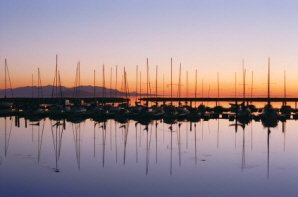
The Great Salt Lake and its islands provide remarkable scenery and unique recreational opportunities less than a half hour west of
Salt Lake City . Sunsets over the lake can be breathtaking. Indescribable colors blend into the evening sky seemingly dissolving before your eyes.
Inland sailors enjoy relaxing days on the lake's turquoise waters. You don’t have to live near the ocean to enjoy sailing.
Many people spend their weekends ... and even a week-day evenings ... on a sailboat on the Great Salt Lake. Full-service marinas are back to being open after the lake almost disappeard. They can be found at Antelope Island and the Great Salt Lake Marina on the lake’s south shore.
White sandy beaches were once popular with swimmers and sunbathers believe it or not. In many places, you can walk out hundreds of yards into the lake and barely have the water reach your knees.
And even if you’re not a great swimmer, the water is so buoyant, you’ll easily float.
Antelope Island and Stansbury Island provide excellent trails for hiking and mountain biking .
With over 10,000 miles of shoreline, kayakers have found the Great Salt Lake to be one of the most enjoyable places to paddle in North America. They get to see things few other people ever get to see.
There's even a world-famous earthworks ... a stunning piece of environmental art ... located at the north end of the lake.
The Spiral Jetty ... built in 1970 ... draws people from all over the world.
Stunning Sunsets
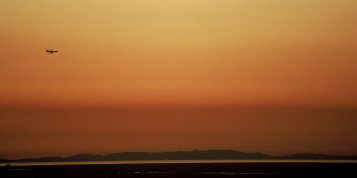
When my kids were younger, we used to enjoy finding a great spot to view the sun going down over the Great Salt Lake on a summer evening.
Some of my best photos have come from these outings. And these views of the lake are readily accessible here:
- Ensign Peak on the north edge of Salt Lake City.
- The east side benches of Bountiful, Centerville and Farmington.
- On Wasatch Boulevard in Holladay above I-215 between 4500 South and The Old Mill Golf Course.
- From numerous Antelope Island trails.
- From I-80 along the lake's south shoreline.
Antelope Island provides excellent picnicking and camping facilities.

What Makes It So Unique?
The lake is quite shallow with an average depth of 20 feet even when full. Winds are quite common out here on the west desert and even moderate winds can cause rough water. Sailors need experience to safely navigate the lake.
You can get in trouble easily on a boat though. Conditions can change for the worse without warning. Rain and lightening strike quickly. Temperatures can plummet.
Overcast days on the lake provide fantastic photographic opportunities. But these days also play tricks on your eyes.
The sky seems to blend into the water on the horizon and the landscape can be illusory. Sailboats skim the surface appearing to float in midair.
There’s Wildlife Here?
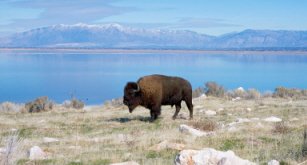
Antelope Island State Park is a dynamite place to view wildlife. Bison. Pronghorn antelope. Mule deer. Bobcat. Coyote. Bighorn sheep. All roam the island freely and are seen frequently by visitors to the island.
The bison herd on the island now numbers more than 600! Antelope Island is reached by driving over a 7.2 mile (8.8 km) paved causeway heading west from I-15 near the city of Layton.
The Great Salt Lake’s shoreline marshes provide some of the best bird watching habitat in the state.
The federally managed Bear River Bird Refuge and the state’s Farmington Bay Waterfowl Management Area are unparalleled. Prodigious numbers and varieties of migratory birds make their home here.
As you might expect, fish can't live in the salt water of the lake. There are freshwater marshes and inlets nearby where fish do live.
One species does thrive in these waters, though. Brine shrimp. A unique species. Aquatic crustaceans which are harvested commercially and processed into fish food.
One irritating species living on the lake's shorelines are brine flies. It is not that they bite. But they swarm. And can shorten a visit to the lake if you’re not aware you’ll probably encounter them.
One good thing? Antelope Island beaches are usually free from brine flies.
What About That Smell?
Residents of the cities up and down the Wasatch Front ... and visitors ... are also familiar with another unique lake “effect”. Winds blowing off the lake, at certain times of the year, are known to bring an unusual odor.
Like rotten eggs. There used to be a number of reasons given for the cause of this smell. But in an article published in 2015, it was explained by researchers.
50% of the water going into Farmington Bay is treated wastewater. It doesn't actually reach the Great Salt Lake according to the researchers.
The Bay, about 15 miles north of Salt Lake City, starts producing this bad odor when the wastewater ... rich in nutrients ... feeds algae blooms that then feed bacteria after they die,
The bad rotten-egg odor comes from the byproduct of the process - hydrogen sulfide gas.
The road to Antelope Island keeps the wastewater confined to the bay. The shallow depth of the bay and the ever-prevalent winds coming off the lake only make it worse,
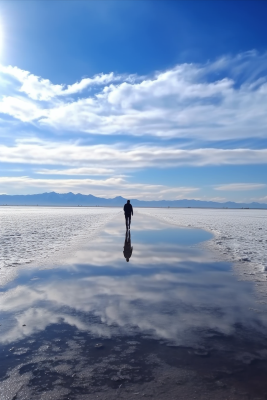
History ... A Little
The Great Salt Lake is what remains of prehistoric Lake Bonneville. This immense lake covered approximately 20,000 square miles in parts of what are now Utah, Nevada and Idaho. Somewhere between 10,000 and 30,000 years ago.
A far cry from what we see today. The lake we are left with ... when full ... is about 75 miles (120 km) long and 35 miles (56 km) wide. A little more than 1/10 of Lake Bonneville's size.
The depth varies little even with varying amounts of mountain runoff. The maximum depth is approximately 33 feet. The surface area may increase or decrease depending on how wet our year was. But the depth varies little.
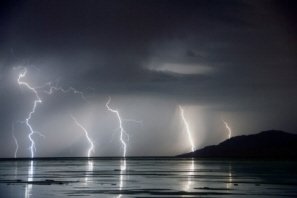
Why Does The Lake Shrink?
Just because the depth varies little, water volumes in the lake are far from constant. There have been years when many of the lake’s 10 major islands became peninsulas.
And in 1983, when the lake reached its modern-day high, it flooded houses, farmland and the nearby freeway. The state constructed monstrous pumps to divert the excess water into Utah's west desert. The pumps are rusting relics now as they were shut down in 1989.
Recent studies have discovered another puzzling anomaly about the depth of the lake. Just because we have a wet year doesn’t mean the lake will rise. In fact, before the drought, it fell after a couple very wet years.
But why? It is because of low groundwater levels. Because of stringing so many dry years together in the last decade, groundwater levels were far below normal levels. Much of the runoff ended up in the ground rather than in streams.
The other reason is that reservoir managers diverted and stored much more water than normal due to reservoirs being so low. So, simply, very little water even reached the Great Salt Lake.
The lake is fed by four rivers and numerous streams. They carry a large volume of dissolved minerals from Utah’s mountains but the lake has no outlet to allow these trapped minerals to move along.
The lake is one gigantic evaporating pool. A huge commercial by-product of this process is table salt.
And few people know that there was once a
town in the middle of the Great Salt Lake.
Parks
There are two Utah State Parks on the Great Salt Lake.
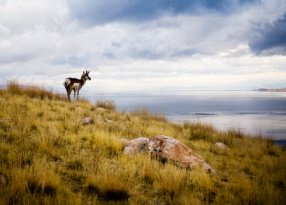
- Antelope Island State Park – clean beaches. A wonderful visitor center. A marina. A ranch house brimming with history. More than 600 bison. Hiking. Mountain biking. Camping.
- Great Salt Lake State Park – a marina ideal for launching sailboats. And historic Saltair. Saltair was a lively resort from the early 1900’s through the 1950's. It is now a mini-museum of the history of the resort. Mural-size photos on the walls will take you back in time. You can also walk into the lake from here and get a wonderful view of Antelope Island.
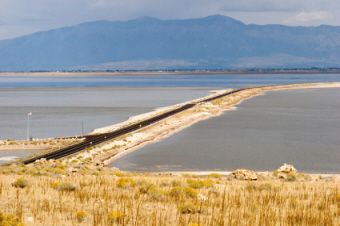
Getting There
Great Salt Lake State Park/Saltair is situated approximately 16 miles (25.6 km) west of Salt Lake City on I-80. Antelope Island takes a little longer but is well worth the drive. Go north on I-15 to Syracuse. Then west on U-127. Follow the signs to the causeway.
The causeway was built to allow automobile access to the island. It’ is a scenic drive on its own.



